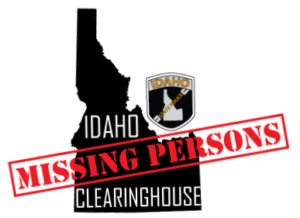Home Fingerprinting &
Background Checks Criminal History
ABIS Sex Offender
Registry Missing Persons
Clearinghouse Uniform Crime
Reporting
Forms
Missing Persons Clearinghouse

Missing Persons By Type
These links lead you to a definition of the category as well as details and photos of the specific cases belonging to a category:
DISABILITY RECORDS | CATASTROPHE RECORDS
ENDANGERED RECORDS | INVOLUNTARY RECORDS
JUVENILE RECORDS | OTHER RECORDS
2023 Idaho Missing Person Clearinghouse report
Please Like, Follow and Share our new Facebook Page https://www.facebook.com/IDMPC
Please follow our twitter feed @ISP_Alerts for all active AMBER Alerts, Blue Alerts and Endangered Missing Person Alerts
New Child ID App from the FBI https://www.fbi.gov/news/stories/2011/august/child_080511
The Idaho Missing Persons Clearinghouse was established in 1999 to provide a central location for resources to identify and assist state and national efforts to locate Idaho’s missing. A missing person is someone whose whereabouts is unknown to a parent, caretaker or others who have normal contact with the person. A missing person can be a runaway child, anyone who has been involuntarily abducted or an Alzheimer’s Patient. There is NO waiting period to report a person missing. As soon as you realize someone is unaccounted for, contact your local Police Department or Sheriff’s Office as well as NCMEC (National Center for Missing or Exploited Children). The Clearinghouse maintains statistical data on Idaho’s missing; develops and provides training to law enforcement on topics relevant to missing persons; creates and provides forms for law enforcement and members of the public to use; as well as maintaining available resources to assist during a missing person event. This section, consisting of a manager and one support staff, works closely with local law enforcement agencies in Idaho and other states. The section utilizes various databases and the general public in developing information, which may assist in locating missing children and adults from Idaho, as well as missing persons from other states who may be in Idaho. This section also performs analytical functions regarding missing and unidentified deceased persons. The section operates a 24-hour toll-free help line to receive messages regarding missing persons. The messages are processed during normal working hours.
Missing Persons Clearinghouse Contact Information
Tanea Parmenter
Missing Persons Clearinghouse Manager
tanea.parmenter@isp.idaho.gov
208.884.7137
208.884.7193 Fax
 Official Government Website
Official Government Website












